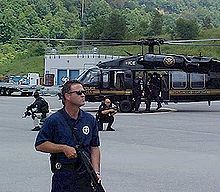
Handcuffs are restraint devices designed to secure an individual's wrists in proximity to each other. They comprise two parts, linked together by a chain, a hinge, or rigid bar. Each cuff has a rotating arm which engages with a ratchet that prevents it from being opened once closed around a person's wrist. Without the key, the handcuffs cannot be removed without specialist knowledge, and the handcuffed person cannot move their wrists more than a few centimetres or inches apart, making many tasks difficult or impossible.

A chain gang or road gang is a group of prisoners chained together to perform menial or physically challenging work as a form of punishment. Such punishment might include repairing buildings, building roads, or clearing land. The system was notably used in the convict era of Australia and in the Southern United States. By 1955 it had largely been phased out in the U.S., with Georgia among the last states to abandon the practice. North Carolina continued to use chain gangs into the 1970s. Chain gangs were reintroduced by a few states during the "get tough on crime" 1990s: In 1995, Alabama was the first state to revive them. The experiment ended after about one year in all states except Arizona, where in Maricopa County inmates can still volunteer for a chain gang to earn credit toward a high school diploma or avoid disciplinary lockdowns for rule infractions.

The Justice Prisoner and Alien Transportation System (JPATS), nicknamed "Con Air", is a United States Marshals Service airline charged with the transportation of persons in legal custody between prisons, detention centers, courthouses, and other locations. It is the largest prison transport network in the world. Though primarily used by the Federal Bureau of Prisons or U.S. Immigration and Customs Enforcement, JPATS also assists military and state law enforcement.

Legcuffs are physical restraints used on the ankles of a person to allow walking only with a restricted stride and to prevent running and effective physical resistance. Frequently used alternative terms are leg cuffs, (leg/ankle) shackles, footcuffs, fetters or leg irons. The term "fetter" shares a root with the word "foot".

A body belt is any waist belt which has D-rings or other attachment points. The belts can be used as medical restraints in institutions for bed and wheelchair restraints, and for safety in activities such as abseiling or construction work. When they are used in sexual bondage plays they are commonly referred to as bondage belts, and also worn in fetish clothing. The belts are usually fastened with buckles and some by a locking mechanism, which enables quick release.

A prison officer (PO) or corrections officer (CO), also known as a correctional law enforcement officer or less formally as a prison guard, is a uniformed law enforcement official responsible for the custody, supervision, safety, and regulation of prisoners. They are responsible for the security of the facility and its property as well as other law enforcement functions. Most prison officers or corrections officers are employed by the government of the jurisdiction in which they operate, although some are employed by private companies that provide prison services to the government.
Thomas Solomon is an American escape artist and magician.

Speedcuffs are a model of handcuff characterised by their rigid grip between the two ratchet cuffs. Their rigid design and the inclusion of a grip makes them effective for gaining control over a struggling prisoner, even if only one cuff has been applied. They are standard issue for most police forces within the United Kingdom.

A ball and chain is a physical restraint device historically used to bind prisoners of both adolescent and adult ages. Their use was prevalent in the Americas. From the 17th century until as late as the mid-20th century this form of punishment was often used in conjunction with other methods of confinement.
The Pendleton Correctional Facility, formerly known as the Indiana Reformatory, is a state prison located in Fall Creek Township, Madison County, near Pendleton and about 25 miles (40 km) northeast of Indianapolis. Established in 1923, it was built to replace the Indiana State Reformatory located in Jeffersonville after a fire severely damaged the original property. The Pendleton facility currently offers maximum and minimum-security housing for adult males over 22 years old. The maximum-security portion is made up of 31 acres (130,000 m2) surrounded by a concrete wall. It has an average daily population of approximately 1,650 inmates. Located on the grounds outside the enclosure, the minimum-security dormitory holds approximately 200 prisoners on a daily basis.

A chain is a serial assembly of connected pieces, called links, typically made of metal, with an overall character similar to that of a rope in that it is flexible and curved in compression but linear, rigid, and load-bearing in tension. A chain may consist of two or more links. Chains can be classified by their design, which can be dictated by their use:

A correctional emergency response team is a team of specially trained prison officers tasked with responding to disturbances, riots, cell extractions, mass searches, and other situations in prisons that are likely to involve uncooperative or violent prisoners.
Hope v. Pelzer, 536 U.S. 730 (2002), was a United States Supreme Court case in which the Court ruled that the defense of qualified immunity, under which government actors may not be sued for actions they take in connection with their offices, did not apply to a lawsuit challenging the Alabama Department of Corrections's use of the "hitching post", a punishment whereby inmates were immobilized for long periods of time.

A police duty belt is a belt, typically constructed of nylon or leather used by police, prison and security officers to carry equipment easily in a series of pouches attached to the belt, in a readily-accessible manner, while leaving the hands free to interact. This belt can carry any number of useful items, ranging from handcuffs to guns.

A prisoner transport vehicle, informally known as a "Sweat Box" or “Court Bus” amongst British prisoners, is a specially designed or retrofitted vehicle, usually a van or bus, used to transport prisoners from one secure area, such as a prison or courthouse, to another. Less commonly, aircraft, railcars or vessels are also similarly fitted. These vehicles must be highly protected and may feature bars or wire mesh over the windows, bulletproof glass, segregated prisoner compartments, and additional seating for escorting officers.
A belly chain is a physical restraint worn by prisoners, consisting of a chain around the waist, to which the prisoner's hands may be chained or cuffed. Sometimes the ankles are also connected by means of longer chains.
The use of shackles or restraints on pregnant women is a common practice in prisons and jails in the United States. Shackling is defined as "using any physical restraint or mechanical device to control the movement of a prisoner's body or limbs, including handcuffs, leg shackles, and belly chains". For females, shackles or handcuffs are placed around the ankles, wrists, or around the stomach. The shackling of pregnant women occurs while they are transported within a facility, transported to a hospital, and/or during and after childbirth. Restraints are also used on detained pregnant women in immigration detention facilities.
Natasha McKenna was a 37-year-old African-American woman who died in Fairfax County, Virginia while in police custody. The catalyst event, extraction from her cell and being tasered while shackled, was captured on the video of the Fairfax County jail.

A jail tree is any tree used to incarcerate a person, usually by chaining the prisoner up to the tree. Jail trees were used on the American frontier in the Territory of Arizona, in the late 19th and early 20th centuries; jail trees were also used in Australia. A few jail trees survive to this day.

A handcuff cover is a plastic or metal cover that can be placed over a pair of handcuffs. It consists of a hinged, box-like assembly locked over the handcuff chain, wristlets and keyholes.
















